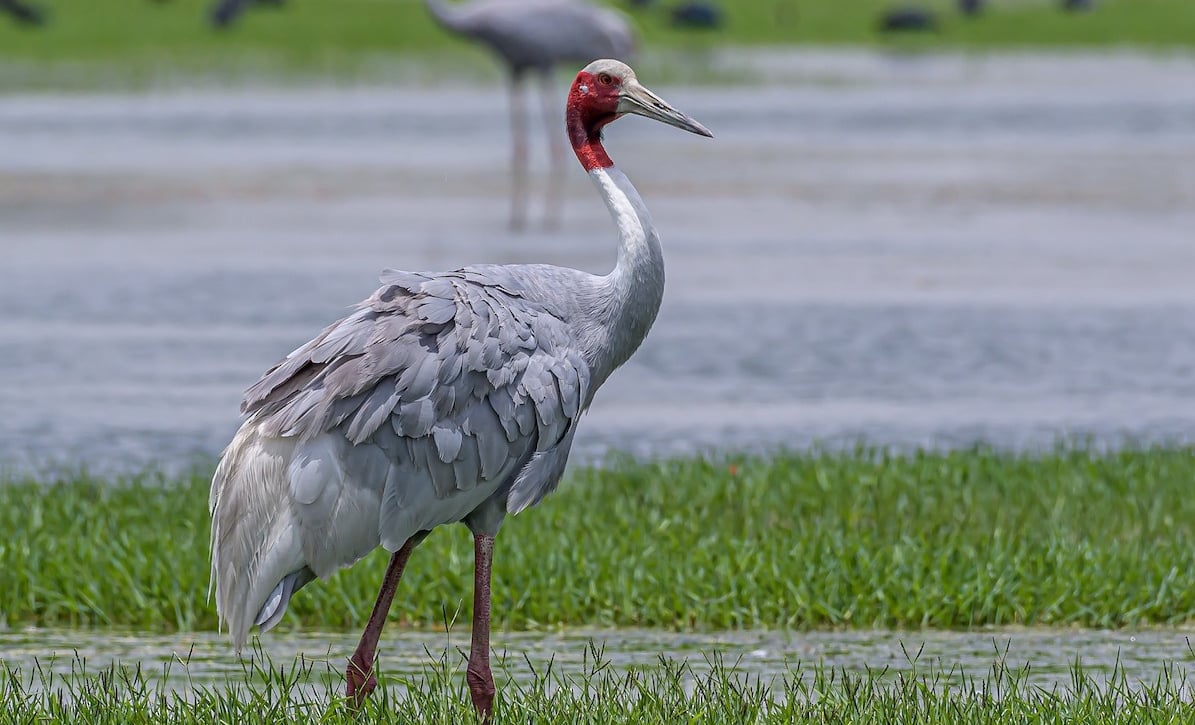May 16, 2025 | 05:20 GMT +7
May 16, 2025 | 05:20 GMT +7
Hotline: 0913.378.918
May 16, 2025 | 05:20 GMT +7
Hotline: 0913.378.918

Rice cultivation areas in the direction of favorable weather and even moorland are ideal environments to attract herds of red-crowned cranes.
A few years ago, under the sponsorship of the BirdLife International program, about 20 hectares of farmland in Anlung Pring province in southeastern Cambodia, near the Vietnamese border, was used to grow a type of short-day rice cranes prefer.
Along with government propaganda, farmers in this area are encouraged to practice crane-friendly farming methods, such as: gradually cutting down the use of pesticides and fertilizers and restricting logging and illegal encroachment into the reserve.
Thanks to this effort, red-crowned cranes still return to the area. According to Mr. Nguyen Hoai Bao, lecturer at the University of Natural Sciences, Vietnam National University, Ho Chi Minh City, an expert on cranes, rice cultivation areas in the direction of favorable weather and even moorland are ideal environments to attract herds of cranes.
"To preserve the red-crowned crane, we first need to find out why the population of cranes is declining. In my opinion, it is due to the general environmental deterioration of the Mekong Delta, in addition to the polluted environment caused by agricultural production", he said.
With decades of experience in conservation, Mr. Bao said that cranes do not return to the Dong Thap Muoi area because they cannot find food in the natural environment.
Dong Thap Muoi and Mekong Delta are the main agricultural regions of Vietnam. This place contributes over 50% of the country's total rice production and about 90% of the export rice output.
Along with neighboring countries such as Cambodia, Thailand, and Myanmar, the demand for agricultural production in Vietnam has increased over the past ten years. That contributes to the crane not returning to this area since the dry season 2022. If the situation does not improve soon, Mr. Bao predicts the possibility of extinction of the red-crowned crane in Vietnam is "severe".
As an indicator of the wetland environment, when cranes no longer appear in Tram Chim National Park - which is likened to a miniature Dong Thap Muoi - environmental degradation and biodiversity loss are natural, according to Mr. Bao.

Tram Chim National Park has more than 230 species of water birds, including rare species such as the red-crowned crane, white-winged goose, great cormorant, greater adjutant, etc. Photo: Hoang Vu.
Ideas about restoring and preserving red-crowned cranes emerged about ten years ago. But for many reasons, Dong Thap province and scientists have not been able to implement it. It was not until this area was no longer cranes that the red-crowned crane conservation project accelerated progress by transferring crane breeds and individuals from Thailand.
“The priority goal is to see the crane again in Tram Chim National Park. We have lost our herd of cranes, and more than ever, if the crane reappears, it will be a source of spiritual encouragement for people and scientists and promote further efforts to restore the environment," said Mr. Bao.
Another meaning of the direct release of cranes into Tram Chim National Park is to assess this place's current environment accurately. Therefore, the conservation of red-crowned cranes does not stop at raising and releasing them into the environment but instead studying and restoring the original ecosystem of this wetland.
Based on the upcoming crane release, Mr. Bao and his colleagues believe there will be more opportunities to mobilize farmers to produce rice organically while linking conservation work with ensuring livelihoods and improving incomes for people living in the Tram Chim National Park buffer zone.
It took Thailand about 30 years to restore the red-crowned crane population. Although he hoped that Vietnam could deploy faster, Mr. Bao acknowledged: The current generation must quickly correct the wrong things done before so that the next generations can live in a better environment.
From restoring the habitat for the red-crowned cranes, the project people aim to restore the ecosystem around the Tram Chim National Park.
"That is the desire of scientists, is to bring back the health of the community, the ecosystem, ensuring harmony with the development of agriculture", said expert Bao.
The whole process of conserving the red-crowned crane will be closely cooperated and transferred by the Thailand side. Along with that, Dong Thap province will take advantage of learning more experiences in ecotourism and how to promote natural images to attract tourists.
With the biodiversity and the appearance of many grasslands, red-crowned cranes have come to Tram Chim National Park to find food over the years.
However, the number of red-crowned cranes returning to Tram Chim National Park is decreasing. In 2021, only three red-crowned cranes returned to Tram Chim, and from 2022 to now, no cranes have been seen here. The red-crowned crane is endangered in the Red Book of Vietnam and the world.
Translated by Ha Phuc

(VAN) Data from 10,000 farming households will help professionalize production organization and support the implementation of the One Million Hectares Program for High-Quality, Low-Emission Rice Cultivation.

(VAN) FAO Director-General QU Dongyu marks International Day of Plant Health at NENA conference.

(VAN) Deputy Minister of Agriculture and Environment Hoang Trung affirmed that floriculture and ornamental plants are a growing industry that receives significant global attention.

(VAN) The three staple crops dominating modern diets – corn, rice and wheat – are familiar to Americans. However, fourth place is held by a dark horse: cassava.
/2025/05/10/4037-3-223011_495.jpg)
(VAN) Remote sensing technology is becoming an indispensable tool in monitoring resources, developing modern agriculture, and protecting the environment in Vietnam.

(VAN) The trash bag used on fishing vessels can withstand rough sea conditions, including level 8 to level 10 winds and waves. Notably, it can be hung anywhere on the boat.

(VAN) African leaders launched the Kampala Declaration on Building Resilient and Sustainable Agrifood Systems in Africa, marking a bold step toward transforming the continent's agriculture.